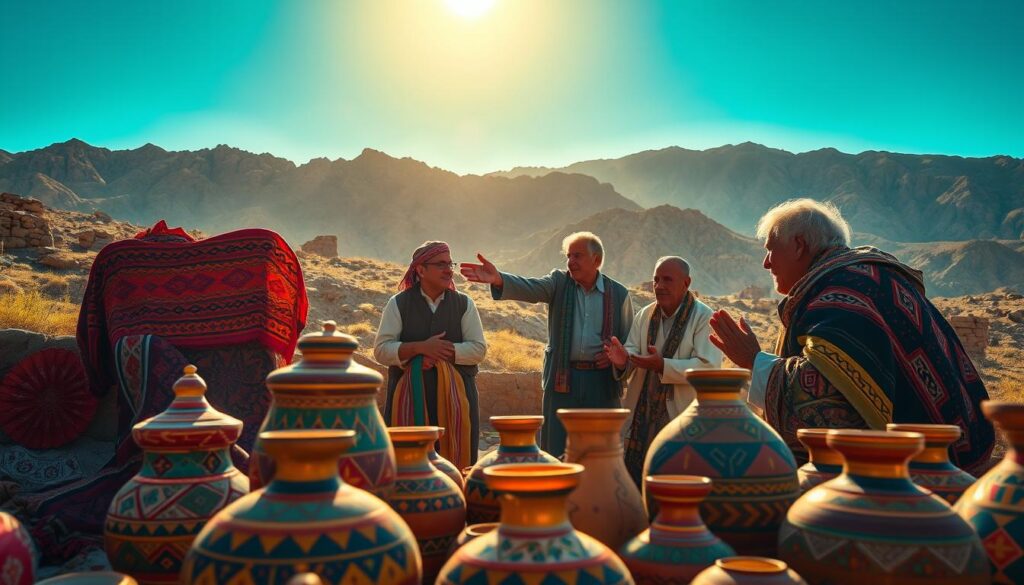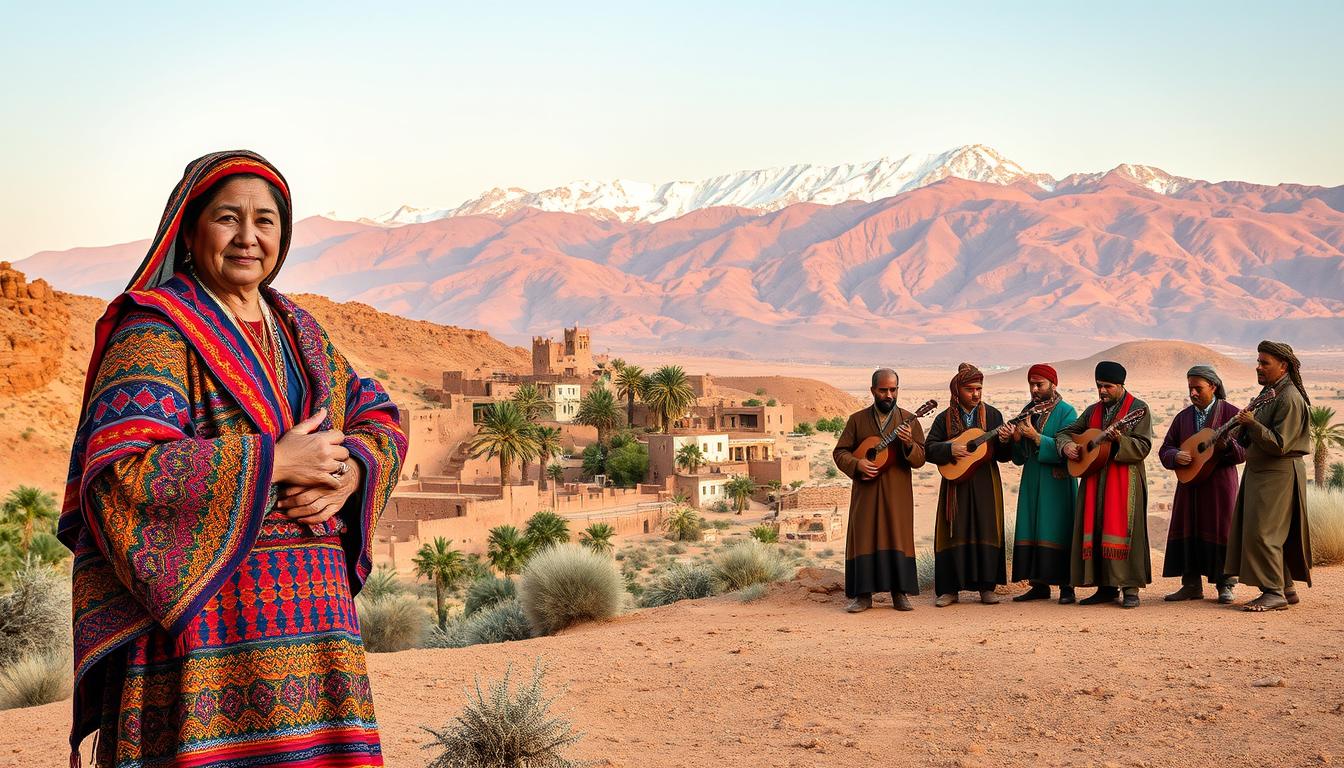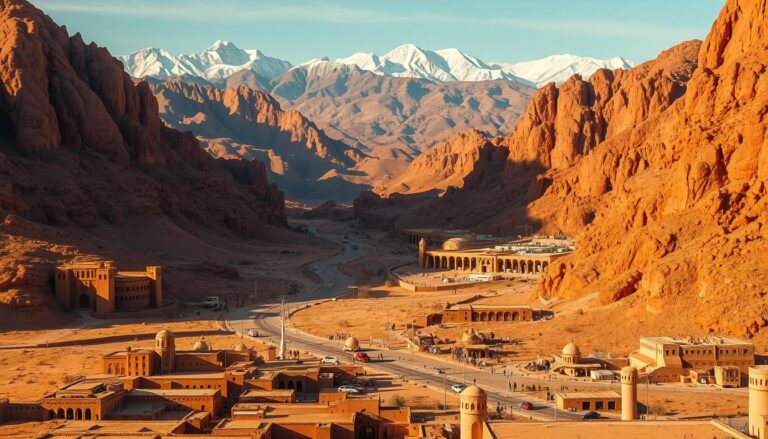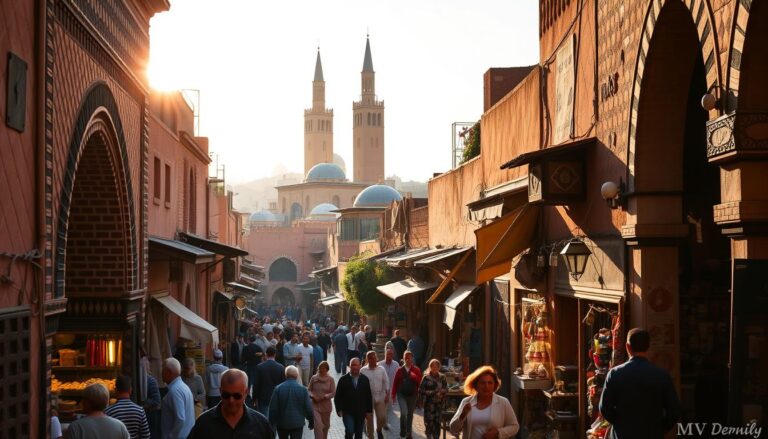The Amazigh of Morocco: A Cultural Treasure
Table of Contents
Did you know that over 40% of Morocco’s population identifies with a culture older than the Arab conquest of North Africa? This vibrant community has preserved its identity through stories, music, and customs passed down for thousands of years. Their legacy isn’t just history—it’s a living tapestry woven into modern life.
You’ll discover how these indigenous guardians have shaped Morocco’s soul. Their language, Tamazight, carries ancient wisdom in every syllable. Even today, it thrives alongside Arabic, reflecting a blend of tradition and adaptation.
Think of oral traditions as time capsules. Songs and poetry aren’t mere entertainment—they’re history books without pages. Through generations, families have used these arts to teach values, celebrate victories, and honor their roots.
What makes this culture so resilient? It’s their ability to evolve while holding firm to core traditions. From colorful textiles to festivals bursting with dance, their way of life remains unbroken. You’ll see how they’ve turned challenges into strength, ensuring their heritage stays alive.
Key Takeaways
- The Amazigh are North Africa’s indigenous people with a history spanning millennia.
- Oral traditions like poetry and music preserve their collective memory.
- Tamazight, their native language, gained official recognition in Morocco in 2011.
- Their cultural practices blend ancient customs with modern influences.
- Amazigh identity is central to Morocco’s national character.
Introduction to the Amazigh Heritage
Imagine walking through a landscape where every mountain and valley tells a story older than written history. North Africa’s indigenous peoples, known for their resilience, have thrived here long before borders defined nations. Their identity isn’t tied to a single country—it’s woven into the very soil beneath your feet.
Setting the Stage: Who Are They?
Often called the “free people,” these communities form the backbone of North African culture. Their traditions stretch back over 4,000 years, surviving empires, invasions, and modernization. You’ll find their influence in everything from place names to local dialects—a testament to their enduring presence.
Discovering North African Roots
What makes this region unique? It’s the blend of ancient customs and adaptability. While neighboring cultures rose and fell, these tribes maintained their distinct practices through oral histories and communal bonds. Their languages, art styles, and social structures reflect a deep connection to the land.
One elder’s saying captures their spirit: “We are like olive trees—our roots go deep, but our branches reach new skies.” This balance between preservation and evolution defines their legacy. As you explore further, you’ll see how their story shapes modern North Africa.
Historical Roots and Cultural Identity
Picture standing where time itself seems carved into the earth. North Africa’s indigenous peoples have shaped this region’s story for over 4,000 years. Their history isn’t locked in museums—it breathes through daily rituals, sacred symbols, and the very rhythm of community life.

Origins and Ancient Traditions
What anchors a culture through millennia? For these communities, it’s their bond with the land. Ancient rock carvings reveal early agricultural practices, while burial sites show spiritual ties to nature. You’ll find their language encoded in geometric patterns on pottery and woven into textiles—a visual alphabet older than Latin.
One proverb whispers: “A people without roots are leaves in the wind.” This truth fueled their survival through Roman rule, Arab conquests, and colonial pressures. By 2011, their linguistic heritage gained official recognition—a turning point marking resilience in modern times.
Preservation Through Oral Tradition
How do you safeguard identity without written records? Through songs that map migration routes and poems recounting droughts survived. Elders become living libraries, teaching children through call-and-response chants under starlit skies.
Festivals burst with masked dancers reenacting creation myths. Every gesture holds meaning—a hand flick mimics sowing seeds, a stomp honors warriors. These traditions aren’t just art. They’re cultural lifelines ensuring no generation forgets its role in the larger story.
Amazigh of Morocco: The Core of Indigenous Traditions
Have you ever wondered what’s in a name? For North Africa’s indigenous communities, it carries the weight of centuries. Their preferred term, Amazigh, translates to “free people”—a declaration of autonomy echoing through generations.
Understanding the Meaning Behind the Name
The label “Berber,” often used by outsiders, carries colonial baggage. Many reject it as mispronounced and dismissive. Choosing their own name became an act of cultural reclamation.
Historically organized into tribes, these groups built societies around shared values like honor and collective responsibility. Each tribe functioned as part of a larger system, maintaining self-governance through councils of elders.
You’ll discover how spiritual practices blended local traditions with Abrahamic faiths. This unique approach to religion became part of their identity, reflected in seasonal festivals and symbolic tattoos.
Language serves as a living archive here. Tamazight dialects vary between regions but share core principles. One elder explains: “Our words map the land—every valley has its voice.”
From the Rif Mountains to Sahara’s edge, tribal distinctions shape collective identity. Yet all remain part of a cultural tapestry woven through language, craftsmanship, and oral histories. Their story proves names aren’t just labels—they’re battle cries for survival.
Language, Art, and Music in Amazigh Culture
What if every word you spoke carried the weight of centuries? The living tapestry of North Africa’s indigenous heritage reveals itself through language that predates empires and art forms surviving modernization. These elements don’t just decorate life—they’re tools of resistance and identity.
The Evolution of the Amazigh Language
You can trace linguistic resilience through numbers. Over 12 million speakers across North Africa keep Tamazight alive today. In 2011, it gained official language status—a milestone validating decades of grassroots teaching efforts.

Oral traditions fuel this survival. Elders pass down vocabulary through market chatter and bedtime stories. One proverb captures this perfectly: “A language lives when children’s tongues dance with it.”
| Aspect | Traditional Form | Modern Influence |
|---|---|---|
| Language | Oral storytelling | School curricula |
| Music | Bendir drums | Fusion genres |
| Textiles | Handwoven symbols | Contemporary fashion |
Traditional Arts and Vibrant Music
Watch artisans transform wool into walking histories. Women master geometric patterns encoding clan stories—skills taught grandmother to granddaughter. The ginbri lute’s three strings mirror life’s balance: past, present, and future.
Festivals erupt with bendir drum circles where everyone becomes both dancer and musician. As one weaver notes: “Threads of wool become stories when hands remember.” These arts don’t just preserve culture—they rewrite it daily.
Amazigh Tribes and Regional Diversity
How does a culture stay vibrant across mountain ranges and desert plains? Over 100 distinct tribes thrive in North Africa, each adapting traditions to their environment. From the Riffians near the Mediterranean to the Cheluh/Shilhah in the Atlas region, these communities prove diversity strengthens identity.
Distinct Tribal Customs and Practices
You’ll find striking differences between tribes just miles apart. Riffian brides wear intricate silver crowns symbolizing prosperity, while southern groups favor indigo-dyed fabrics to ward off desert heat. One elder shares: “Our rituals are like fingerprints—no two are alike, but all belong to the same hand.”
Geographical Impact on Cultural Variations
Mountain tribes developed terraced farming techniques over centuries. Meanwhile, desert-dwelling groups mastered water conservation for oasis agriculture. The Atlas region’s total population relies on communal grain storage, contrasting with coastal peoples who prioritize fishing traditions.
Language dialects shift noticeably across regions too. Northern tribes use borrowed Spanish words, reflecting historical trade ties. Southern dialects incorporate Saharan influences, proving how geography shapes communication.
This regional richness creates a cultural mosaic. Whether through woven patterns or harvest festivals, every tribe adds threads to North Africa’s living tapestry. Their differences don’t divide—they deepen connections to land and legacy.
Modern Life, Challenges, and Social Change
What keeps a culture alive when the world around it changes rapidly? For North Africa’s indigenous communities, balancing tradition with progress remains a daily tightrope walk. Their way of life faces pressures from urbanization and shifting government policies, yet creative solutions emerge.
Contemporary Issues and Cultural Revival
Land disputes spark heated debates as ancestral territories shrink. One activist explains: “Our connection to the earth isn’t just about soil—it’s our history written in every rock.” Over 60% of rural families rely on agriculture, making land rights central to economic survival.
| Challenge | Traditional Approach | Modern Solution |
|---|---|---|
| Farming | Seasonal crop rotation | Drought-resistant techniques |
| Education | Oral storytelling | Bilingual school programs |
| Governance | Elder councils | Youth advocacy groups |
The Role of Women and Community
You’ll find women leading the charge in cultural preservation. From weaving cooperatives to language classes, they bridge generations while asserting economic independence. Nearly 40% of artisan businesses are female-led—proof that tradition fuels progress.
Community networks thrive through shared responsibilities. Men and women collaborate on water management projects, blending ancestral knowledge with new technology. As one teacher notes: “Schools now teach both soil science and our elders’ wisdom—that’s how roots grow stronger.”
Conclusion
Can a language carry the soul of a people across millennia? The vibrant indigenous legacy you’ve explored reveals how identity thrives through adaptation. From mountain villages to urban centers, traditions persist in schools, festivals, and daily life—proof that “roots grow deeper when shared.”
Women lead this cultural revival, with over 40% of artisan businesses female-led. Their work sustains history while creating economic independence. Official recognition of Tamazight in 2011 marked a turning point, empowering new generations to embrace their heritage.
Challenges like land rights debates and educational gaps remain. Yet communities innovate, blending ancestral farming techniques with modern agriculture. Over 12 million speakers keep their linguistic legacy alive, ensuring traditions evolve without losing meaning.
You’ve seen how society transforms when culture fuels progress. Whether through woven textiles or rhythmic drum circles, this living heritage invites you to listen closer. Their story isn’t just preserved—it’s being written anew every day.







